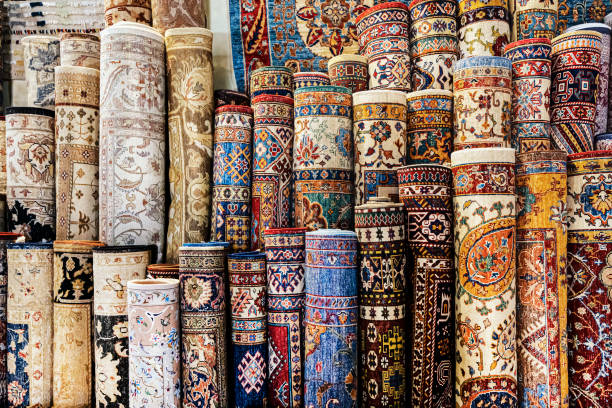Choosing retro rugs for your house is not as difficult as you think. Using the right decor items, you can create a perfect combination of style and quality home. This blog will inspire you to find the right Rug for your space and how interior designers use it in tit designs.
What does the word “retro” actually mean
The term “retro” is often used to describe items that imitate, evoke, or mimic the past’s style, design, or fashion. The term retro describes a vintage or nostalgic aesthetic inspired by past decades, usually the 20th Century. The Latin word “retro” means “backward or behind.”
Retro is often used to describe something that embodies cultural or historical elements, such as trends and characteristics. It can be applied to many aspects, including fashion, music and art, interior design or technology, and societal attitudes. Retro styles or items are created or designed to create nostalgia, celebrate the past, or evoke sentimental feelings.
Retro-style dresses may include high waistlines, A-line skirts, or bold patterns reminiscent of the 1960s or 1950s. Retro music is a style that emulates sounds and techniques from a specific era. It’s often associated with certain instruments, production methods, or musical influences.
A side note: The specific style or period associated with “retro” may vary depending on the context, personal preferences, and cultural influence. Retro today is not necessarily retro from the past.
What is retro interior design and home decor
Let’s talk about retro interior design before choosing retro rugs. Retro interior design and home decor refers to using previous decades’ styles, colors, and elements to create a nostalgic and vintage-inspired environment within a house. This involves using design elements and aesthetics of the mid-20th Century, especially the 1950s, 1960s, and 70s.
Retro home decor and interior designs share some characteristics
Color palette: Retro styles often use bold, vibrant colors. Oranges, yellows, and greens are popular choices. Colors like these are often used to decorate walls, furniture, and other decor items. They create an energetic and lively atmosphere.
Geometric patterns, abstract prints, and bold prints dominate retro decor. Popular designs include floral motifs, chevrons, and mod-inspired shapes. You can find these patterns in wallpaper, upholstery fabrics, and rugs.
Furniture: Retro furniture is often characterized by sleek lines, smooth curvatures, and organic forms. Standard furniture includes armchairs, sofas with tapered feet, Eames chairs, and tulip-shaped tables. Materials like molded plastics, chrome, Formica, and vinyl are commonly used.
Accessories: Retro decor includes various accessories that enhance the vintage feel. Some examples include lava lamps, shag rugs, rotary dial phones, vintage radios, and mid-century lighting fixtures such as Sputnik crystal chandeliers. You can incorporate framed vintage posters, abstract art, or pop art.
Retro-inspired appliances. Some homeowners choose retro-styled devices to complement their vintage kitchens. These appliances are often rounded, have pastel colors and nostalgic details, but still incorporate modern functionality.
Retro wallpapers: Wall treatments with colorful, bold patterns were popular in the retro era. Using retro wallpapers to achieve this look is a great way to create the desired effect. Retro design also includes wood paneling, textured wall treatments, and accent walls with geometric patterns.
Retro decor is all about celebrating past styles and aesthetics. You can combine retro elements with modern touches to create an interior that is balanced and tailored to your taste.
Decorating Your Home with Retro Area Rugs
Selecting the right furnishings for your interior design may be difficult. It is also hard to buy the perfect vintage Rug.
Retro rugs are popular amongst rug collectors and general consumers. They also appeal to those who love their unique design and characteristics. Retro rugs are not only popular among rug enthusiasts but also with general consumers. They are also favorites of interior designers.
Five Modern Designers Who Love Mid-Century Vintage Retro Rugs
Mid-century modern area rugs, mod trappings, and chic interiors embrace the mid-century revival. Some people go all in, while others incorporate a representative piece of the past into a modern interior. These designers are responsible for the vintage mid-century modern retro rugs you see in magazines.
Jayne Michaels and Joan Michaels, NYC interior designers, use retro rugs
Jayne Michaels and Joan Michaels are twin sisters who have become interior designers. They know their stuff. 2Michaels Design, a New York City-based company, won the Design Center of the Americas “Stars on the Rise Award” in 2012. The chic interiors of the duo have been a hit with the design community. Swedish carpets/kilims in retro colors dominate the team’s contemporary interiors.
Ryan Korban is a fan of retro rugs
Ryan Korban, a young designer with a fresh face, has created a buzz for his exotic-luxe interiors. New York’s boyish designer effortlessly integrates furs and animal prints into Rockstar-worthy interiors. You can often find kilims and mid-century rugs in the designer’s eclectic interiors.
Designer Nina Garcia & Her Beautiful Retro Rugs
Nina Garcia is a talented designer. Her position as creative director at Marie Claire speaks volumes about her. Everyone wants to see what the trendsetters are doing with their spaces. The Manhattan home of the fashion maven is filled with fluffy Moroccan carpets, Swedish rya shag carpets, and kilims, paired with elegant Hollywood Regency furniture that lights up Architectural Digest.
Retro Rugs by Palmer Weiss
The West Coast decorating queen Palmer Weiss has embraced mid-century modern rugs. Her style is a unique blend of California casual and Southern sophistication. Her best work pairs Beni-Ourain carpets and posh cottage-style furnishings. The result is perfection. Enjoy this winning combination by taking a page out of Palmer’s book.
Retro Moroccan Rug with a Nate Berkus interior
Nate Berkus is a perennial crowd-pleaser who has mastered incorporating midcentury elements into his timeless, livable interiors. Nate Berkus often uses flat-weave dhurries and Beni Ourain carpets in his personal and professional work. This mix of elegance and earthiness was reinforced by Ikat fabrics and Moroccan-influenced latticework pillow designs demonstrating mid-century creations’ versatility.

